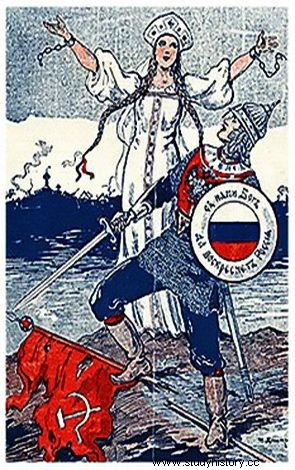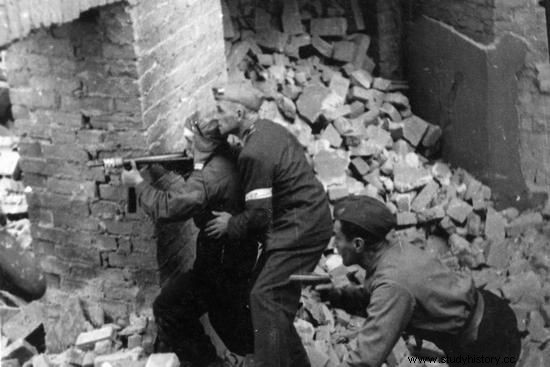You've probably heard about General Andrei Vlasov's Russian Liberation Army collaborating with Germany. But did you know that in the occupied territories of the USSR a whole state was created, led by ... the Russian Nazi party?
Łokoć is a small town, which before the Third Reich's attack on the USSR was located in the Orłów district (now in Bryansk). At first glance, it was nothing special. Well, maybe except for one detail:it was in this area that the "counter-revolutionaries" released from the labor camps were settled, who were not allowed to live in Moscow, Leningrad and other large cities of the Soviet empire.
That is why, when Łokoć was occupied by German troops in October 1941, in the minds of engineers from the local distillery - Konstantin Pawłowicz Woskobojnik and Bronisław Władysławowicz Kamiński - the idea of creating a collaborative Republic of Łokock was born.
At the side of the Germans
Both "founding fathers" went to the commander of the German 2nd Panzer Army, General Heinz Guderian with their idea. He liked their idea very much and on November 15, 1941, the Łokocki Self-Government District was established, headed by Woskobojnik.
The new administrative unit was equipped with its own paramilitary (voluntary) militia, which was to fight the Bolshevik partisans. This formation took the name of the Russian People's Liberation Army (RONA), and its commander was none other than Bronisław W. Kamiński.

Approximate location of the Lokota Republic on the Barbarossa Operation Map. In the upper right year, the exact borders of the republic, situated between the Bryansk, Kursk and Orlov Oblasts.
The founders of the Łokocki Republic, encompassing several regions of the Orłowski and Kursk oblasts, carried out a number of economic reforms in order to win over the local population. Among other things, the hated kolkhozes were dissolved by returning the land to the peasants and the promotion of private trade - so fought by the communists - was promoted. The education and health of the inhabitants were also not forgotten, which resulted in the opening of a number of schools, hospitals and medical aid points.
As Boris Sokolow writes in his book "The USSR Under Occupation":
Nationalism became the official ideology of the Łokocki Republic, and the ruling party was the Russian National Socialist Party . Dogmas of national socialism, adapted to Russian conditions, were propagated among the masses by "Golos Nation". Anti-Semitism was an important point on this agenda.
One party (Nazi), one leader
Moscow could not allow the existence of the supported by the population, tolerated by the Germans and the Nazi republic on Russian soil. Joseph Stalin ordered the partisan units located in this region to fight ruthlessly.
On January 8, 1942, Woskobojnik was killed in an ambush organized by them. His place was taken by Bronisław W. Kamiński, combining civil and military power in his hands. From that moment on, he held the positions of Ober-burgomister and kombrig and the Łokot propaganda created him as the father of the Russian nation, who will sit in the Kremlin after the victory of the Germans over the Bolsheviks .
For now, however, Kamiński has not even been able to control the situation in his small "country". The Soviet partisans, using terror that were difficult to describe on a large scale, were becoming an increasing problem. Its scale is best evidenced by the fact that the partisans shot, hanged or tortured to death over 10,000 people (of which about 200 were burned alive).
The Bolsheviks also blew up 24 villages. All this resulted in a significant increase in desertions from the RONA ranks. Another problem was the plague of drunkenness spreading among soldiers and civilians (disturbing even for Soviet conditions!), which could not be stopped by draconian punishments, including shooting.

Propaganda poster of the Łokocki Republic
The situation became more and more dramatic with each passing month. After the defeat of the 6th Army of Paulus at Stalingrad, it seemed that even before the spring of 1943, the Red Army would recapture the territories of the Łokocki Republic from the German hands. Therefore, Kamiński decided to evacuate the male part of the population, while those refusing to leave were automatically considered partisans and ended up in front of the firing squad.
Systematic purges of the former Soviet assets also began. As reported by Sokołów - an NKVD captain operating in the pro-Kremlin partisans: prisoners are shot and hanged in large numbers, 30-50 a day . The Germans also did not believe in keeping the front. Therefore, they decided to organize their own partisan formation from Kaminski's units, which was to operate at the rear of the Red Army. However, with almost the last of their strength, the Axis forces managed to stop the advancing Soviet troops and the evacuation of Łokocie has not yet taken place. The situation could not last long, however, and in August 1943 another attack by the Red Army broke through the German lines, which was tantamount to the destruction of the Łokocki Republic.
This article has more than one page. Please select another one below to continue reading. You are not on the first page of the article. If you want to read from the beginning click here.Further fate of Kamiński:executioner of the Warsaw Uprising
Before this happened, however, Kamiński managed to evacuate his forces - at that time around 12,000 soldiers - to the vicinity of the town of Lepiel in Belarus, of which Bronisław Władysławowicz became a burgomaster, and at the same time became the head of the Local Government Region of Lepiel. In the following months, the Russian People's Liberation Army fought fiercely against the Soviet partisans (it also included RONA deserters), achieving considerable success in the first half of 1944.

After the fall of the Łokocki Republic, the remnants of the Russian People's Liberation Army were transferred to Belarus, where they fought against the Soviet partisans. RONA was headed by Bronisław Kamiński (with a patch inside).
It made no difference, however, in the face of another crushing blow from the Red Army. Kaminski and his men had to withdraw again. This time they ended up in the General Government. At the same time, Himmler promoted the kombrig to SS-Brigadeführer and the soldiers under his command were part of the Waffen-SS as the SS "RONA" Assault Brigade.

This unit was used, inter alia, to suppress the Warsaw Uprising . On this occasion, she showed unimaginable bestiality and insubordination, which eventually resulted in an order to arrest her commander. As Sokołow writes in his book:
Kombrig somehow found out about it and decided to flee to the Carpathian Mountains to join the UPA troops there. However, it is rather doubtful whether the Ukrainian insurgents would be satisfied with the appearance of the SS Brigadeführer among them. Near Tarnów in southern Poland, Kaminski's car was stopped by the men of the head of the Krakow SD, Walter Birkamp, who personally shot a kombrig. Later, a bandit attack on him was staged and RONA soldiers were notified of the death of their commander. It happened at the end of September or the beginning of October 1944.
Another version of Kamiński's death is given by Norman Davis in his book Powstanie 44, who claims that Brigadeführer was summoned to Łódź and died in a fake car accident. On the other hand, Józef K. Wroniszewski in the work entitled "The 4th Circuit of the Home Army Ochota, District of Warsaw" states that he was shot on the personal order of Erich von dem Bach-Zelewski. Whichever of the above versions is true, Kaminski became inconvenient for the Germans and he paid for it with his life.

In August 1944, wetboys from RONA took part in the pacification of the Warsaw Uprising. At the same time, they showed such cruelty that even the Germans were terrified by their deeds.
His soldiers, who were included in the ranks of the Armed Forces of the Committee for the Liberation of the Nations of Russia under General Andrei Vlasov at the end of the war, also met a poor end. Like other members of this formation who managed to surrender to the Western Allies, they were sent to the Soviet Union, where a firing squad awaited them or, at best, a long stay in a labor camp.
